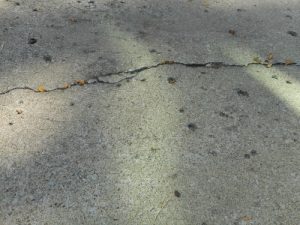It’s that time of year again! It’s time to get back outside! When you do, you’ll notice the flowers are in bloom, the grass is thicker and greener, and the trees have flowering buds that turn to leaves. Spring is springing, indeed! When that happens, you plan to sharpen your lawnmower’s blades, find your wheelbarrow, and pick a weekend to clean up your flower beds and fill them with mulch. You notice cracks in your driveway as you go in and out of the garage. A more careful inspection leads to the discovery that there are cracks in your driveway, and the driveway appears to be sinking near the garage. What in the heck is happening?
Do cracks mean your driveway is sinking?
Cracks in your driveway may indicate that there are voids (empty spaces) under your driveway, and these voids under your concrete cause it to sink. If the gap between your garage floor and your driveway is noticeable, your concrete driveway is sinking. If there is a void under the driveway, it is due to the dirt compacting over time. The driveway will continue to sink unless you fill the voids. Dirt compacts due to moisture evaporating in the soil under the driveway. A sinking driveway may also be the result of erosion. Whatever the cause, the fix is filling the void with state-of-the-art polyurethane mudjacking foam and lifting the concrete back into place.
Use Foam over Traditional Mud Jacking
The typical mud jacking process comprises a mixture of cement, dirt, and water. When the water in this process evaporates, just like it did in the soil, you will once again have the same issue. Your driveway will once again sink. Polyurethane is impervious to water; it will not sink, and during the injection process, it expands 7 feet in either direction, filling every empty pocket as it does. Traditional mud jacking is thick and does not expand. As a result, voids may be missed.
There are many reasons why foam is a better choice for lifting your concrete driveway, sidewalk, porch, or basement floor.
- The holes needed to inject the foam under the concrete are smaller, and fewer holes are required.
- The foam expands 7ft in either direction, ensuring all voids are filled.
- Foam jacking is impervious to the weather.
- Polyurethane foam weighs less and will not sink again.
- Foam jacking can lift concrete in small, tighter areas. There is no need for large equipment to drive on your grass.
Fix Cracks in the Driveway.
Cracks in your driveway left untreated will lead to more expensive, necessary fixes that could include a total driveway replacement. 

I’m glad I found your article about using slab lifting to be able to fix cracks in the driveway. We’ve got a lot of unwanted cracks in our driveway, and I think that being able to use slab lifting could be really helpful in getting our driveway back to a good condition. I’m going to have to call a slab lifting company, and make sure he’s using the concrete foam, and not home insulation foam like you said!
Thanks for pointing out . This information will help me alot . Really great article. Would like to see more blogs about Driveway . Keep it up
Cracks are really big problem for driveways. Fixing them is not that easy. It costs a lot. Thanks for sharing your suggetions. really appreciate this post..
Thanks for pointing out the reason for driveway cracks and also for the tips. Really helpful post. Keep it up